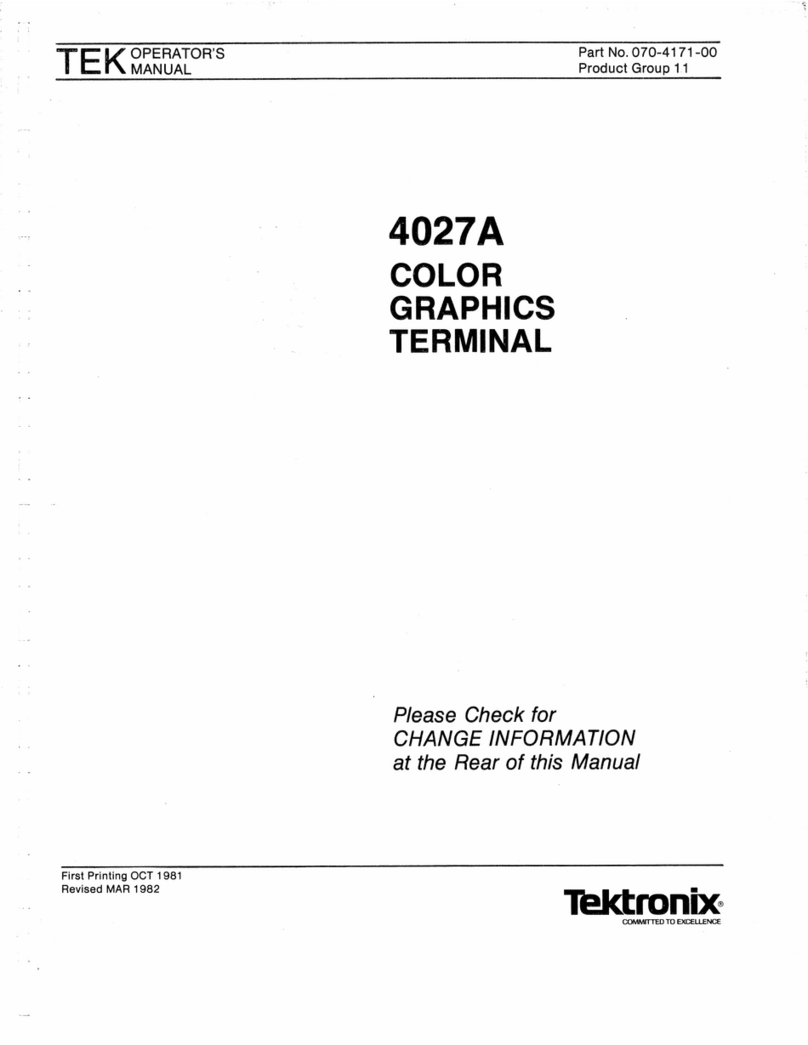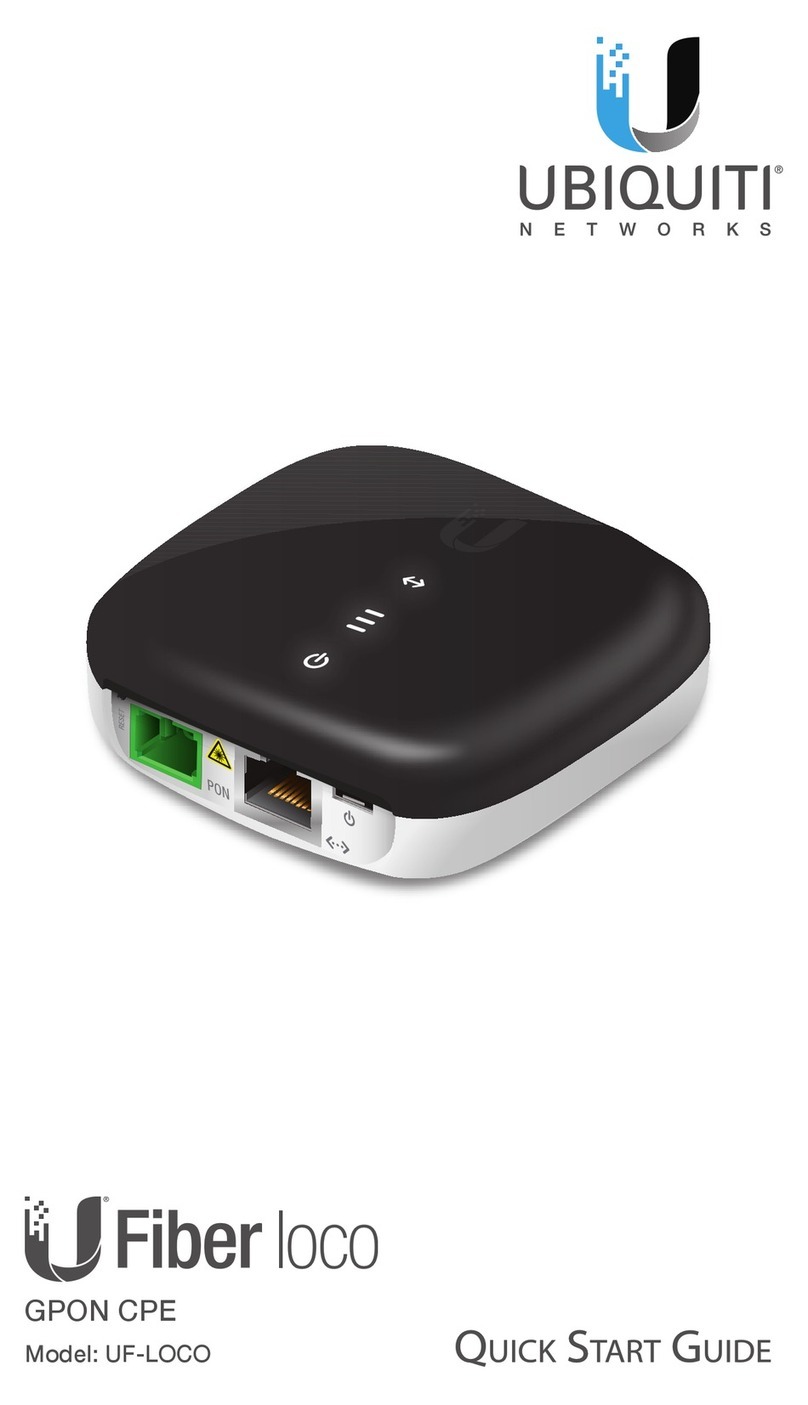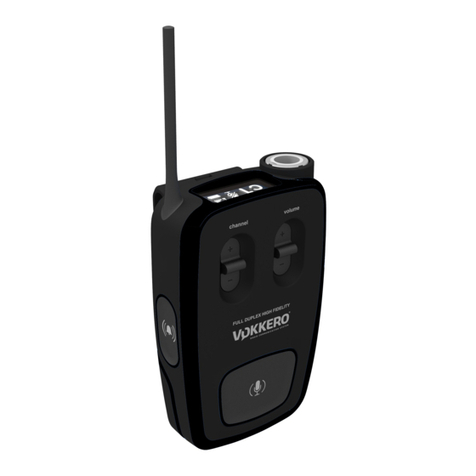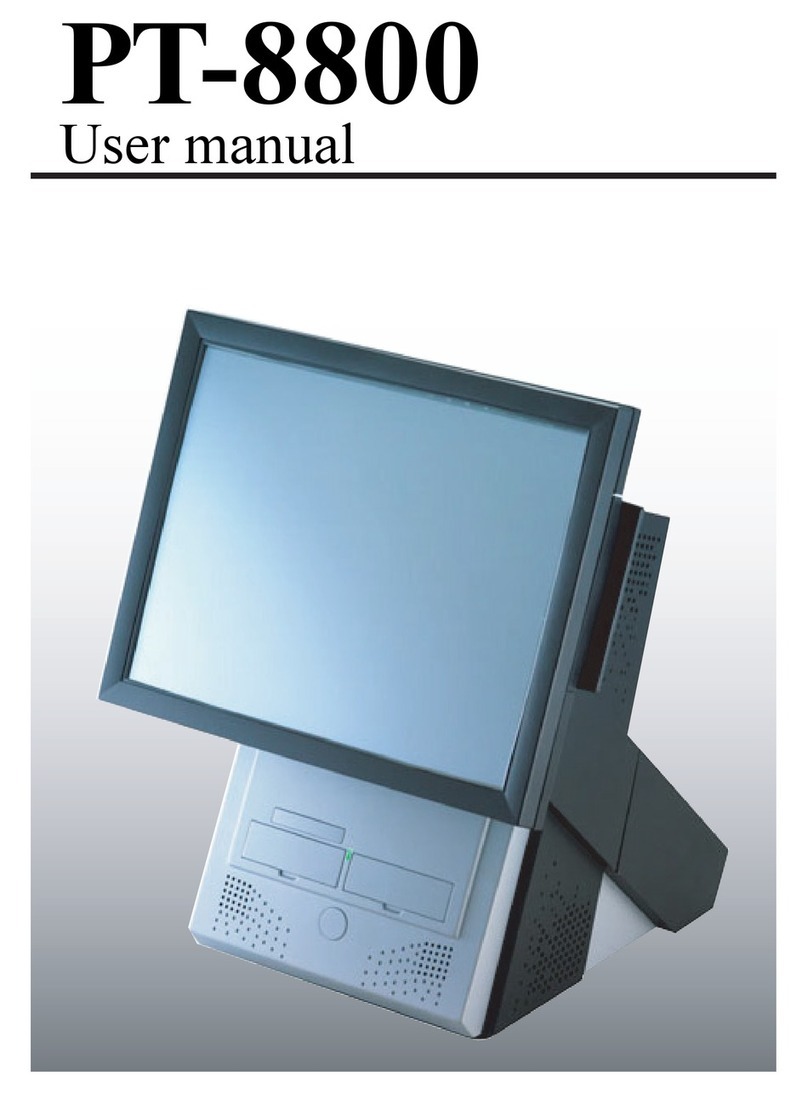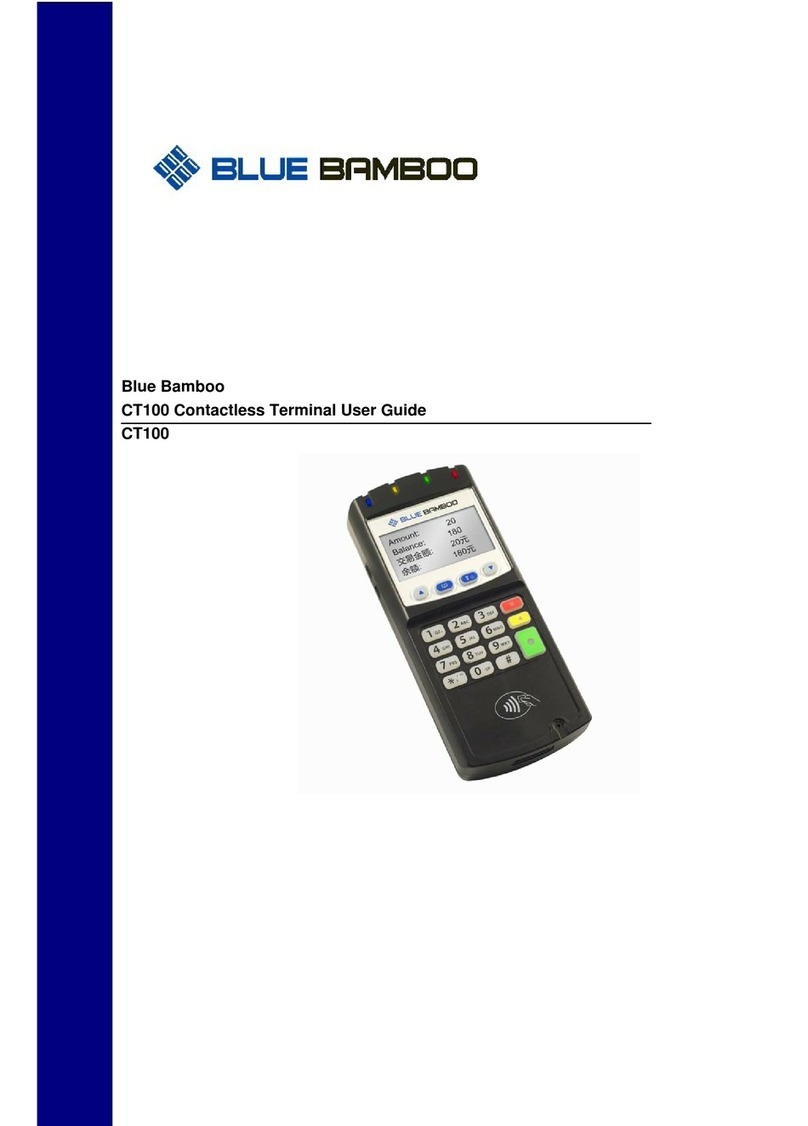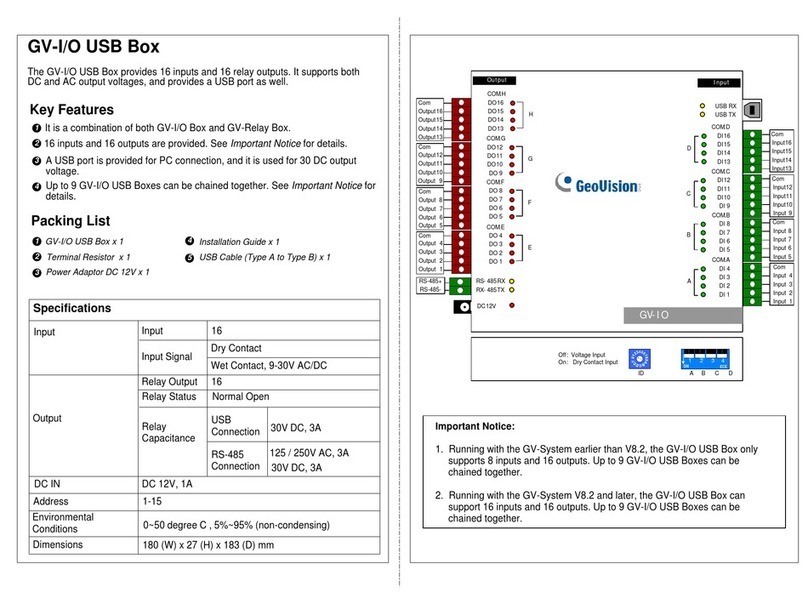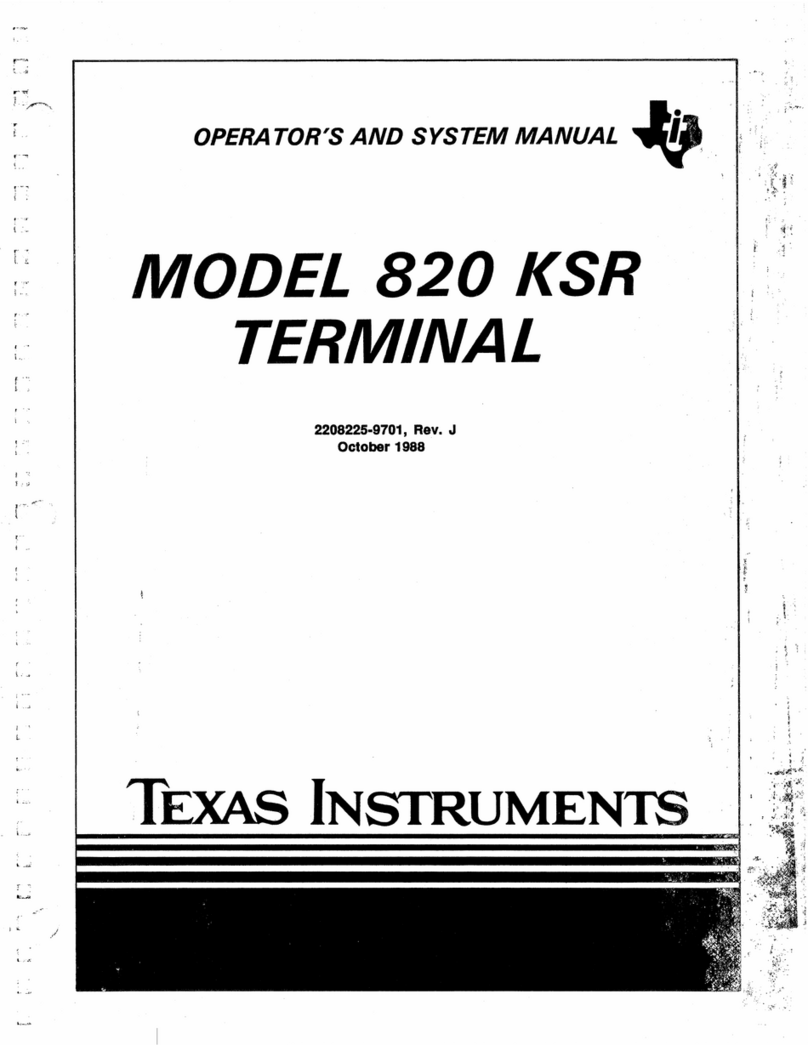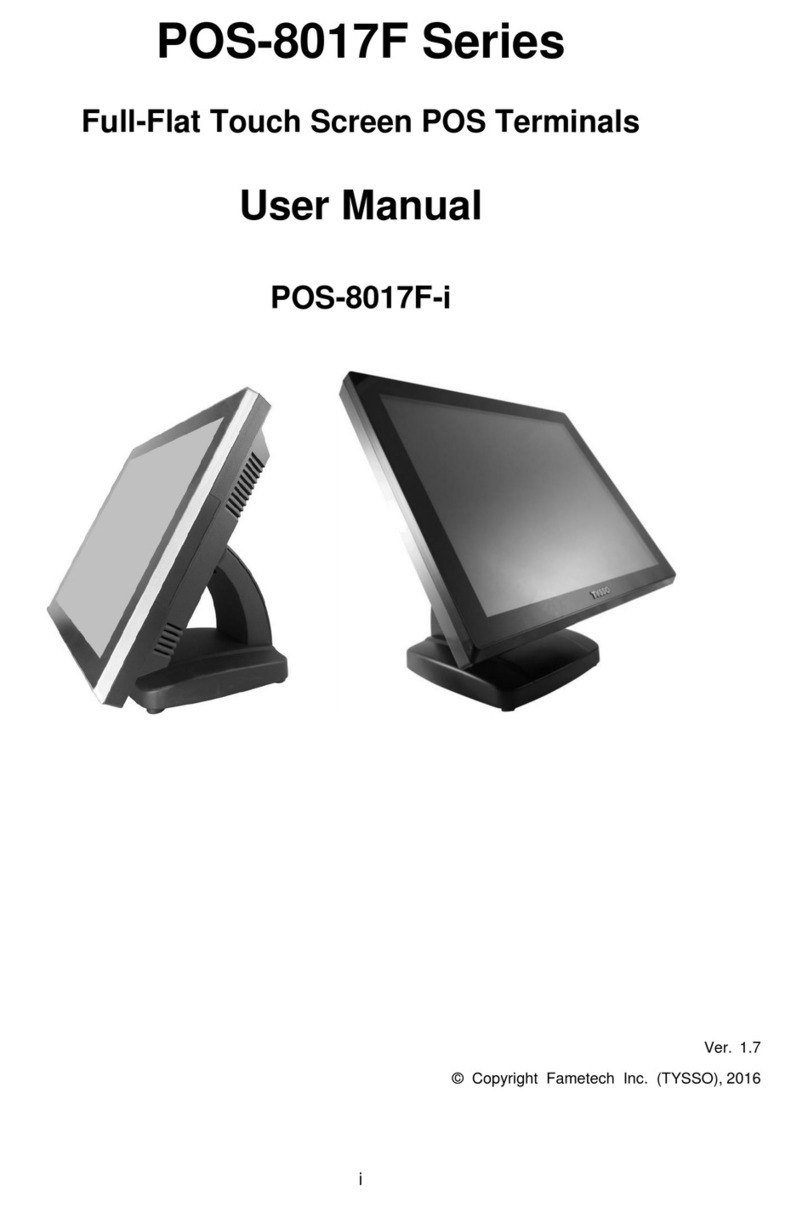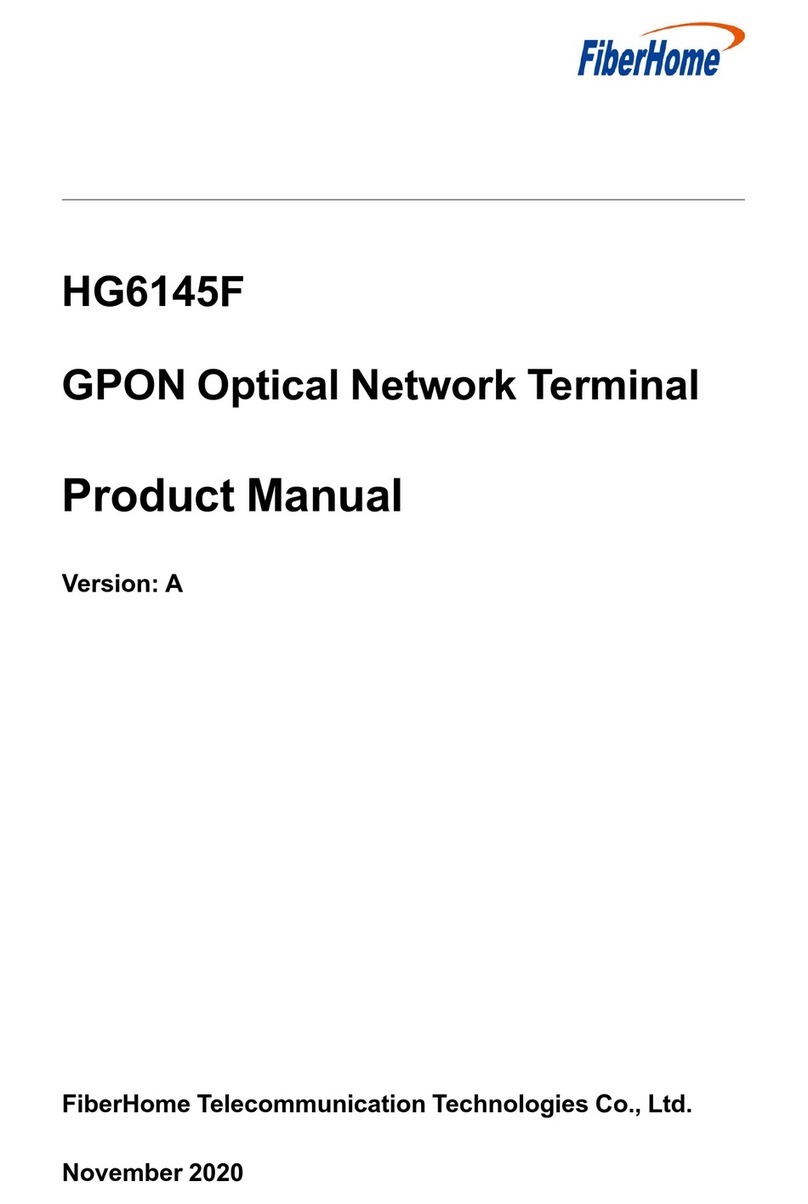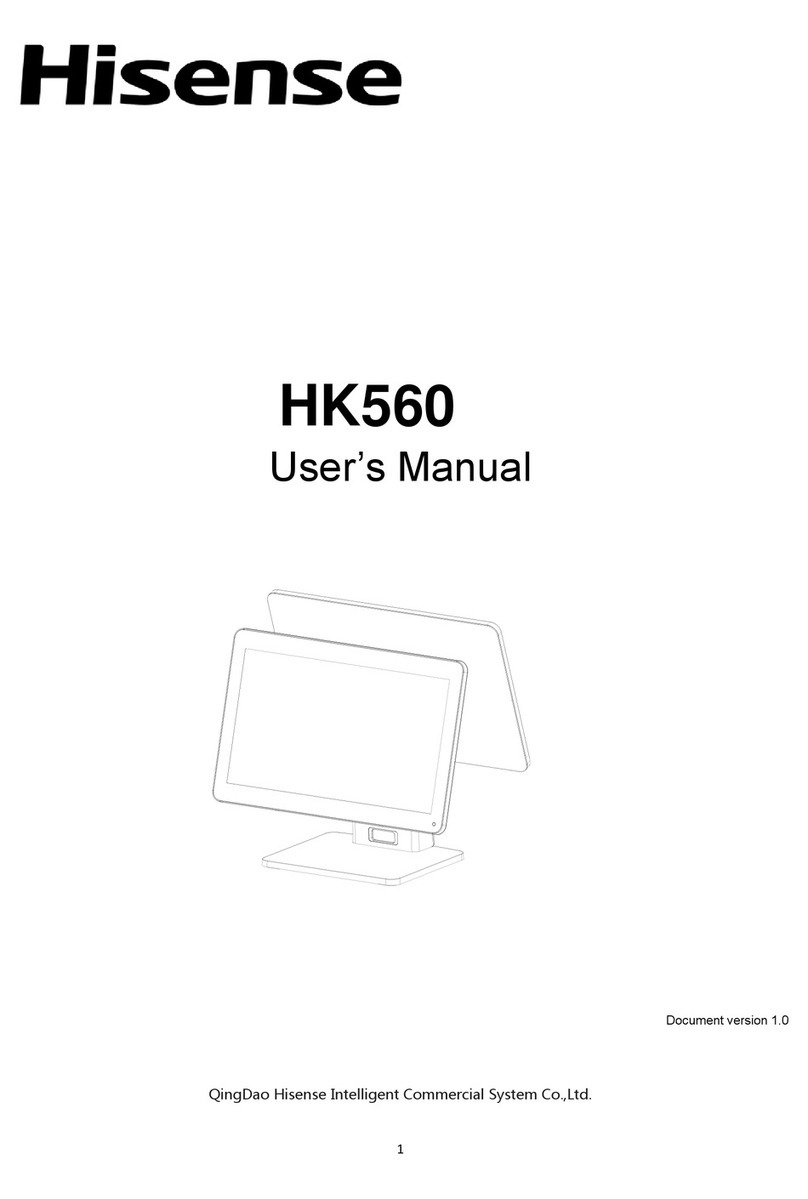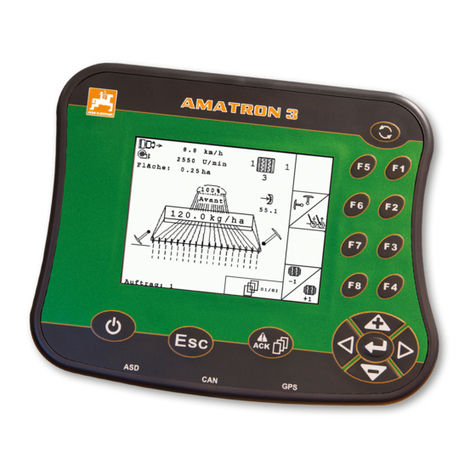Iniven PTR-1500 User manual

PTR-1500
AUDIO TONE TELEPROTECTION TERMINAL
5 Columbia Road, Somerville, NJ 08876
Phone: 908-722-3770 Toll Free: 800-526-3984 Fax: 908-722-5461
INSTRINSTR
INSTRINSTR
INSTRUCTION MANUUCTION MANU
UCTION MANUUCTION MANU
UCTION MANUALAL
ALAL
AL

PTR-1500
AUDIO TONE TELEPROTECTION TERMINAL
INSTRINSTR
INSTRINSTR
INSTRUCTION MANUUCTION MANU
UCTION MANUUCTION MANU
UCTION MANUALAL
ALAL
AL
3.1.03
i

WARRANTY AGREEMENT
We hereby certify that the INIVEN product line carries a warranty for any part
which fails during normal operation or service for 12 years. A defective part should
be returned to the factory after receiving a return material authorization number
(RMA), shipping charges prepaid, for repair f.o.b. Somerville, New Jersey. In case
INIVEN cannot promptly return the unit to you it will endeavor to provide a loaner
until the repair or replacement is returned to you. Any unauthorized repairs or
modifications will void the warranty. In the case of parts not being commercially
available, INIVEN reserves the right to replace the unit with a functionally equivalent
unit.
5 Columbia Road, Somerville, NJ 08876
ii

SAFETY
Standard safety precautions must be followed at all times when installing, operating, servicing
and repairing this equipment. INIVEN assumes no liability for failure to observe safety
requirements or to operate this equipment for purposes other than intended.
GROUNDING
A suitable ground is required to reduce the hazard of shock. Refer to the enclosed module,
chassis, and/or cabinet wiring diagram for ground connection locations.
ENVIRONMENT
Operation of any electrical equipment in area containing gas, fumes, wetness or dampness is a
potential safety hazard. Necessary precautions should be taken.
MANUAL
Operators and maintenance personnel should read this manual before installing the equipment
and placing it in service. Only properly trained personnel with proper tools and equipment should
operate, maintain, repair or service this equipment.
SHOCK
Potentially dangerous electrical shock can occur when working on this product. Protective
measures and safety procedures should be observed at all times.
iii

TABLE OF CONTENTS
Title Page - - - - - - - - - - - - - - - - - - - - - - - - - - - - - - - - - - - - - - - - - - - - - - - - - - - - - - - - i
Warranty - - - - - - - - - - - - - - - - - - - - - - - - - - - - - - - - - - - - - - - - - - - - - - - - - - - - - - - - - ii
Safety Information - - - - - - - - - - - - - - - - - - - - - - - - - - - - - - - - - - - - - - - - - - - - - - - - - - iii
Table of Contents - - - - - - - - - - - - - - - - - - - - - - - - - - - - - - - - - - - - - - - - - - - - - - - - - - iv
Section 1. General
Description - - - - - - - - - - - - - - - - - - - - - - - - - - - - - - - - - - - - - - - - - - - - - - - - - - 1-1
Features - - - - - - - - - - - - - - - - - - - - - - - - - - - - - - - - - - - - - - - - - - - - - - - - - - - 1-1
Logic Mode Options - - - - - - - - - - - - - - - - - - - - - - - - - - - - - - - - - - - - - - - - - - - 1-2
Channel Frequencies - - - - - - - - - - - - - - - - - - - - - - - - - - - - - - - - - - - - - - - - - - 1-3
Trip Times - - - - - - - - - - - - - - - - - - - - - - - - - - - - - - - - - - - - - - - - - - - - - - - - - - 1-3
System Operation - - - - - - - - - - - - - - - - - - - - - - - - - - - - - - - - - - - - - - - - - - - - 1-4
System Block Diagram - - - - - - - - - - - - - - - - - - - - - - - - - - - - - - - - - - - - - - - - - 1-4
Security Charts - - - - - - - - - - - - - - - - - - - - - - - - - - - - - - - - - - - - - - - - - - - - - - - 1-5
Dependability Charts - - - - - - - - - - - - - - - - - - - - - - - - - - - - - - - - - - - - - - - - - - - 1-6
Section 2. Installation
Unpacking - - - - - - - - - - - - - - - - - - - - - - - - - - - - - - - - - - - - - - - - - - - - - - - - - - 2-1
Mounting - - - - - - - - - - - - - - - - - - - - - - - - - - - - - - - - - - - - - - - - - - - - - - - - - - - 2-1
Electrical Connections - - - - - - - - - - - - - - - - - - - - - - - - - - - - - - - - - - - - - - - - - 2-2
Trip Input - - - - - - - - - - - - - - - - - - - - - - - - - - - - - - - - - - - - - - - - - - - - - - - - - - - 2-2
Trip & Guard Output - - - - - - - - - - - - - - - - - - - - - - - - - - - - - - - - - - - - - - - - - - - 2-2
Status Relays - - - - - - - - - - - - - - - - - - - - - - - - - - - - - - - - - - - - - - - - - - - - - - - - 2-2
Audio Tone Lines - - - - - - - - - - - - - - - - - - - - - - - - - - - - - - - - - - - - - - - - - - - - - 2-2
Grounding - - - - - - - - - - - - - - - - - - - - - - - - - - - - - - - - - - - - - - - - - - - - - - - - - - 2-2
Power Connections - - - - - - - - - - - - - - - - - - - - - - - - - - - - - - - - - - - - - - - - - - - 2-2
Initial Start-up - - - - - - - - - - - - - - - - - - - - - - - - - - - - - - - - - - - - - - - - - - - - - - - - 2-3
Wiring Diagram - - - - - - - - - - - - - - - - - - - - - - - - - - - - - - - - - - - - - - - - - - - - - - 2-7
Section 3. Specifications
Module Location - - - - - - - - - - - - - - - - - - - - - - - - - - - - - - - - - - - - - - - - - - - - - 3-1
Specifications - - - - - - - - - - - - - - - - - - - - - - - - - - - - - - - - - - - - - - - - - - - - - - - - 3-2
DIP Switch Settings - - - - - - - - - - - - - - - - - - - - - - - - - - - - - - - - - - - - - - - - - - - 3-4
Transmitter - - - - - - - - - - - - - - - - - - - - - - - - - - - - - - - - - - - - - - - - - - - - 3-4
Receiver - - - - - - - - - - - - - - - - - - - - - - - - - - - - - - - - - - - - - - - - - - - - - - 3-6
Logic Card - - - - - - - - - - - - - - - - - - - - - - - - - - - - - - - - - - - - - - - - - - - - - 3-8
Outline Drawing - - - - - - - - - - - - - - - - - - - - - - - - - - - - - - - - - - - - - - - - - - - - - - 3-11
Section 4. Standard Modules
4-A. DC/DC Module
Controls and Indicators - - - - - - - - - - - - - - - - - - - - - - - - - - - - - - - - - - - - 4-A-1
Description - - - - - - - - - - - - - - - - - - - - - - - - - - - - - - - - - - - - - - - - - - - - 4-A-1
Theory of Operation - - - - - - - - - - - - - - - - - - - - - - - - - - - - - - - - - - - - - - - 4-A-1
Block Diagram - - - - - - - - - - - - - - - - - - - - - - - - - - - - - - - - - - - - - - - - - - 4-A-2
Replaceable Parts - - - - - - - - - - - - - - - - - - - - - - - - - - - - - - - - - - - - - - - 4-A-3
Schematic - - - - - - - - - - - - - - - - - - - - - - - - - - - - - - - - - - - - - - - - - - - - - 4-A-5
iv

4-B. Line Interface Module
Controls and Indicators - - - - - - - - - - - - - - - - - - - - - - - - - - - - - - - - - - - - - 4-B-1
Description - - - - - - - - - - - - - - - - - - - - - - - - - - - - - - - - - - - - - - - - - - - - - 4-B-1
Theory of Operation - - - - - - - - - - - - - - - - - - - - - - - - - - - - - - - - - - - - - - - 4-B-1
Block Diagram - - - - - - - - - - - - - - - - - - - - - - - - - - - - - - - - - - - - - - - - - - 4-B-2
Replaceable Parts - - - - - - - - - - - - - - - - - - - - - - - - - - - - - - - - - - - - - - - - 4-B-3
Schematic - - - - - - - - - - - - - - - - - - - - - - - - - - - - - - - - - - - - - - - - - - - - - - 4-B-5
4-C. Status Relay Module
Controls and Indicators - - - - - - - - - - - - - - - - - - - - - - - - - - - - - - - - - - - - - 4-C-1
Description - - - - - - - - - - - - - - - - - - - - - - - - - - - - - - - - - - - - - - - - - - - - - - 4-C-1
Relays - - - - - - - - - - - - - - - - - - - - - - - - - - - - - - - - - - - - - - - - - - 4-C-2
Theory of Operation - - - - - - - - - - - - - - - - - - - - - - - - - - - - - - - - - - - - - - - 4-C-2
Block Diagram - - - - - - - - - - - - - - - - - - - - - - - - - - - - - - - - - - - - - - - - - - 4-C-3
Replaceable Parts - - - - - - - - - - - - - - - - - - - - - - - - - - - - - - - - - - - - - - - - 4-C-4
Schematic - - - - - - - - - - - - - - - - - - - - - - - - - - - - - - - - - - - - - - - - - - - - - - 4-C-5
4-D. Transmitter Module
Controls and Indicators - - - - - - - - - - - - - - - - - - - - - - - - - - - - - - - - - - - - - 4-D-1
Description - - - - - - - - - - - - - - - - - - - - - - - - - - - - - - - - - - - - - - - - - - - - - - 4-D-2
Theory of Operation - - - - - - - - - - - - - - - - - - - - - - - - - - - - - - - - - - - - - - - 4-D-2
Block Diagram - - - - - - - - - - - - - - - - - - - - - - - - - - - - - - - - - - - - - - - - - - 4-D-3
DIP Switch Settings - - - - - - - - - - - - - - - - - - - - - - - - - - - - - - - - - - - - - - - 4-D-4
Replaceable Parts - - - - - - - - - - - - - - - - - - - - - - - - - - - - - - - - - - - - - - - - 4-D-6
Schematic - - - - - - - - - - - - - - - - - - - - - - - - - - - - - - - - - - - - - - - - - - - - - 4-D-9
Receiver Module
Controls and Indicators - - - - - - - - - - - - - - - - - - - - - - - - - - - - - - - - - - - - - 4-E-1
Description - - - - - - - - - - - - - - - - - - - - - - - - - - - - - - - - - - - - - - - - - - - - - - 4-E-2
Theory of Operation - - - - - - - - - - - - - - - - - - - - - - - - - - - - - - - - - - - - - - - 4-E-2
Block Diagram - - - - - - - - - - - - - - - - - - - - - - - - - - - - - - - - - - - - - - - - - - - 4-E-2
DIP Switch Settings - - - - - - - - - - - - - - - - - - - - - - - - - - - - - - - - - - - - - - - 4-E-3
Replaceable Parts - - - - - - - - - - - - - - - - - - - - - - - - - - - - - - - - - - - - - - - - 4-E-5
Schematic - - - - - - - - - - - - - - - - - - - - - - - - - - - - - - - - - - - - - - - - - - - - - - 4-E-7
Logic Module
Controls and Indicators - - - - - - - - - - - - - - - - - - - - - - - - - - - - - - - - - - - - - 4-F-1
Description - - - - - - - - - - - - - - - - - - - - - - - - - - - - - - - - - - - - - - - - - - - - - - 4-F-1
Theory of Operation - - - - - - - - - - - - - - - - - - - - - - - - - - - - - - - - - - - - - - - - 4-F-2
Block Diagram - - - - - - - - - - - - - - - - - - - - - - - - - - - - - - - - - - - - - - - - - - - 4-F-3
DIP Switch Settings - - - - - - - - - - - - - - - - - - - - - - - - - - - - - - - - - - - - - - - 4-F-4
SET/AutoSET - - - - - - - - - - - - - - - - - - - - - - - - - - - - - - - - - - - - - - - - - - - 4-F-6
Replaceable Parts - - - - - - - - - - - - - - - - - - - - - - - - - - - - - - - - - - - - - - - - 4-F-7
Schematic - - - - - - - - - - - - - - - - - - - - - - - - - - - - - - - - - - - - - - - - - - - - - - 4-F-9
v

4-G. Multi-Trip I/O Module
Controls and Indicators - - - - - - - - - - - - - - - - - - - - - - - - - - - - - - - - - - - 4-G-1
Description - - - - - - - - - - - - - - - - - - - - - - - - - - - - - - - - - - - - - - - - - - - 4-G-2
Theory of Operation - - - - - - - - - - - - - - - - - - - - - - - - - - - - - - - - - - - - - - 4-G-2
Block Diagram - - - - - - - - - - - - - - - - - - - - - - - - - - - - - - - - - - - - - - - - - 4-G-2
Replaceable Parts - - - - - - - - - - - - - - - - - - - - - - - - - - - - - - - - - - - - - - - 4-G-3
Schematic - - - - - - - - - - - - - - - - - - - - - - - - - - - - - - - - - - - - - - - - - - - - 4-G-5
4-H. Hybrid Splitter Module
Description - - - - - - - - - - - - - - - - - - - - - - - - - - - - - - - - - - - - - - - - - - - - 4-H-1
Theory of Operation - - - - - - - - - - - - - - - - - - - - - - - - - - - - - - - - - - - - - - 4-H-2
Block Diagram - - - - - - - - - - - - - - - - - - - - - - - - - - - - - - - - - - - - - - - - - 4-H-2
Jumper Settings - - - - - - - - - - - - - - - - - - - - - - - - - - - - - - - - - - - - - - - - 4-H-3
Replaceable Parts - - - - - - - - - - - - - - - - - - - - - - - - - - - - - - - - - - - - - - 4-H-4
Schematic - - - - - - - - - - - - - - - - - - - - - - - - - - - - - - - - - - - - - - - - - - - - 4-H-5
Section 5. Chassis
Description - - - - - - - - - - - - - - - - - - - - - - - - - - - - - - - - - - - - - - - - - - - - - - - - - 5-1
Mother Board - - - - - - - - - - - - - - - - - - - - - - - - - - - - - - - - - - - - - - - - - - - - - - - - 5-2
Interface Board - - - - - - - - - - - - - - - - - - - - - - - - - - - - - - - - - - - - - - - - - - - - - - 5-2
Back Board - - - - - - - - - - - - - - - - - - - - - - - - - - - - - - - - - - - - - - - - - - - - - - - - - 5-2
Options - - - - - - - - - - - - - - - - - - - - - - - - - - - - - - - - - - - - - - - - - - - - - - - - - - - - 5-2
Mother Board Schematic - - - - - - - - - - - - - - - - - - - - - - - - - - - - - - - - - - - - - - - 5-3
Interface Board Schematic - - - - - - - - - - - - - - - - - - - - - - - - - - - - - - - - - - - - - - 5-4
Terminal Block Board Schematic - - - - - - - - - - - - - - - - - - - - - - - - - - - - - - - - - 5-5
Section 6. Option Modules
Section 7. Maintenance
Preventative Maintenance - - - - - - - - - - - - - - - - - - - - - - - - - - - - - - - - - - - - 7-1
Module Removal - - - - - - - - - - - - - - - - - - - - - - - - - - - - - - - - - - - - - - - - - - - - 7-1
Module Replacement - - - - - - - - - - - - - - - - - - - - - - - - - - - - - - - - - - - - - - - - - 7-1
Fuse - - - - - - - - - - - - - - - - - - - - - - - - - - - - - - - - - - - - - - - - - - - - - - - - - - - - - 7-1
vi

Section 1 GENERAL
Figure 1-1. PTR-1500
DESCRIPTION
The PTR-1500 is a communications system used for the protection of electric power generation and
distribution equipment. A protection system consists of two PTR-1500 units that communicate with each
other via voice-grade telecommunication lines (i.e., carrier, wire line or metallic pairs, fiber optics, and
microwave). The basic operation consists of a unit receiving a voltage from a closed contact (Trip input)
from a relay into the transmitting terminal and having it communicate to the receiving terminal, which
provides a closed contact and a externally sourced voltage output (Trip output).
FEATURES
DESIGN: The PTR-1500 has been optimized for high speed, high Dependability, and high Security. Single
and Dual Channel FSK modulation techniques are used in conjunction with digital differential Guard/Trip
energy sensing. These methods have a proven record of accomplishment for high reliability in the tone
protection relaying applications.
PROGRAMMABILITY: Operating characteristics of the PTR-1500 are controlled by firmware. The majority
of parameter changes are accomplished by changing DIP switch settings. A few logic changes are made
by PROM/EPROM replacement. Frequencies, channel bandwidths, communications protocols, and logic
modes are all programmable.
COMPATIBILTY: The PTR-1500 is compatible with other INIVEN PTR equipment as well as certain other
manufacturer’s audio tone protection equipment, depending on their configuration.
STABLE OPERATION: The Digital Signal Processing (DSP) technology used to generate the transmitter
frequency, establish receiver frequency discrimination, and manage all channel filtering, is crystal controlled.
This design provides a high level of stability, which overcomes the drift with temperature and age problem
encountered with analog methods.
1-1

LOGIC MODE OPTIONS
The PTR-1500 is designed as a four channel communications system that can operate in three different
modes depending on how the Logic module is programmed
1. DUAL CHANNEL – two frequencies are always generated by the Transmitter, either two Guard
tones or two Trip tones, one from Sub-Channel A and one from Sub-Channel B, from the selected
frequency Group (see Table 1-1) chosen by the customer. The Guard frequencies, one from each
Sub-Channel, are transmitted during normal, non-Trip, operation. When a Trip input is received by
the PTR-1500, the Transmitter will output both Trip frequencies, one from each Sub-Channel. The
PTR-1500 connected to the other end of the communication line will only allow a Trip output to the
receiving end’s relay when it has received both Trip signals simultaneously. The use of two frequencies
for Guard and Trip signals dramatically increases the Security (see Security charts later in this
section) of the system.
2. SINGLE CHANNEL – one frequency is generated by the Transmitter, either a Guard or Trip tone.
The frequencies will be either Sub-Channel A or B, but not both, of the selected frequency Group
(see Table 1-1) chosen by the customer. The Guard frequency is transmitted during normal, non-
Trip, operation. When a Trip input is received by the PTR-1500, the Transmitter will output the Trip
frequency and the PTR-1500 connected to the other end of the communication line will allow a Trip
output.
3. DUAL INDEPENDENT – two frequencies are generated by the Transmitter. The system operates
as two Single Channel units simultaneously. In this configuration, two separate Trip inputs are
received by the PTR-1500. Trip input 1 will be transmitted using a single frequency, Sub-Channel A
of a frequency Group (see Table 1-1) chosen by the customer. During normal, non-Trip, operation
the Transmitter will output the Sub-Channel A Guard tone. When a Trip input is received by the PTR-
1500 from Trip input 1, the Transmitter will output the Sub-Channel A Trip tone and the PTR-1500
connected to the other end of the communications line will allow a Trip 1 output. Trip input 2 will
cause the system to operate the Guard and Trip tones of Sub-Channel B in the same manner as
described for Trip input 1. Each Trip input will operate independently of the other.
Because the PTR-1500 is a four channel unit, it can operate 2 of the above logic schemes independently in
the same unit. The 2 “halves” of the unit need not be the same. For example, a PTR-1500 can be ordered
with 2 Dual Channels, a Dual Channel and a Single Channel, a Dual Independent and a Single Channel,
etc….
The PTR-1500 can also be ordered as a single direction or as the standard bi-direction. A single direction
unit can only transmit or receive while a bi-directional unit can do both. These options may also be combined
with the different logic configurations.
FSK MODULATION
340Hz Channel Spacing: ± 75 Hz
680Hz Channel Spacing: ±150 Hz
1-2

CHANNEL FREQUENCIES
TABLE 1-1. Standard Frequency Groups
TYPICAL TRIP TIMES
Channel speed is measured with back-to-back terminals and does not include delays inherent in the
communication media. For those units equipped with the optional Trip Relays, add approximately 3ms to
the times indicated below.
EDOMGNICAPSLENNAHC
zH043zH086
YTIRUCESHGIHsm21sm8
DEEPSHGIHsm9sm6
TABLE 1-2. Trip Speed
1-3
SEICNEUQERFENOTDEDNEMMOCER
HTDIWDNABLANIMONzH071-GNICAPSLENNAHC-BUSzH043
PUORGLENNAHC-BUSEDOM&YCNEUQERFYCNEUQERFRETNECLENNAHC-BUS
1A
B
068
0101
0021
0531
pirT
drauG
drauG
pirT
zH539
zH5721
2A
B
0021
0531
0451
0961
pirT
drauG
drauG
pirT
zH5721
zH5161
*3 A
B
0451
0961
0881
0302
pirT
drauG
drauG
pirT
zH5161
zH5591
*4 A
B
0881
0302
0222
0732
pirT
drauG
drauG
pirT
zH5591
zH5922
*5 A
B
0222
0732
0652
0172
pirT
drauG
drauG
pirT
zH5922
zH5362
6A
B
0652
0172
0092
0503
pirT
drauG
drauG
pirT
zH5362
zH5792
7A
B
0092
0503
0423
0933
pirT
drauG
drauG
pirT
zH5792
zH5133
HTDIWDNABLANIMONzH043-GNICAPSLENNAHC-BUSzH086
8A
B
587
5801
5641
5671
pirT
drauG
drauG
pirT
zH539
zH5161
*9 A
B
5641
5671
5412
5442
pirT
drauG
drauG
pirT
zH5161
zH5922
01 A
B
5412
5442
5282
5213
pirT
drauG
drauG
pirT
zH5922
zH5792
.lennahcnoitacinummocfodnereppurorewoltaffo-llordiovaotdnaesionmuminimrofspuorGderreferP*
.tseuqernoelbaliavaeragnicapsdnaseicneuqerfTTICC

SYSTEM OPERATION
The following is a brief description of the standard modules that comprise a typical terminal. For detailed
descriptions, schematics and parts lists, refer to the individual module’s section in this manual.
POWER SUPPLY: Accepts the station battery voltage from the Line Interface module and produces a
regulated +5V output. It also isolates the rest of the PTR 1500 from the station battery.
LOSS OF POWER ALARM RELAY: A SPDT relay will be located on the Interface board, the wiring
connections are a 3 terminal board strip next to the power supply.
STATUS RELAY MODULE: Contains 8 relays that indicate problems with the communications system: 2-
Alarm, 2-Block, 4-LOS (Loss of Signal).
DC/DC MODULE: Contains overvoltage and undervoltage detectors that will disable the PTR-1500 Trip
circuits if the supply voltage is out of limit. The card produces ±12VDC outputs.
LOGIC MODULE: The PTR-1500 requires two Logic modules for quad channel operation. The Logic
module monitors all Trip inputs, furnishes all instructions to the tone Transmitter, analyzes the tone Receiver
outputs, and controls the Trip output drivers for one Dual Channel. The module also controls the Status
Relay module and monitors the DC/DC module. The Logic module utilizes a Z80 processor as its CPU.
LINE INTERFACE MODULE: Contains power supply filters, ON/OFF switch, and fuses. It also couples the
communication lines using four transformers.
MULTI-TRIP I/O MODULE: Contains five Trip input optical isolators and eight solid state outputs optically
isolated (4 - Trip and 4 - Guard).
TRANSMITTER MODULE: The PTR-1500 requires one Transmitter module (Quad-tone plus two pilot
tones). Utilizing the TMS320C16 DSP, the Transmitter performs calculations necessary to synthesize
required tone frequencies and to execute required control functions.
RECEIVER MODULE: The PTR-1500 requires two Receiver modules (two channels per Receiver module)
for quad channel operation. The Receiver utilizes the TMS320C16 DSP, which performs all calculations
necessary for tone filtering, control functions, and noise detection.
1-4
Figure 1-2. PTR-1500 Block Diagram

SECURITY CHARTS
Security charts showing the PTR-1500’s ability not to false Trip in the presence of noise.
STANDARD SECURITY
0
100000
200000
300000
400000
500000
600000
700000
800000
900000
1000000
NOISE
BURSTS
(per Trip)
-12 -11 -10 -9 -8 -7 -6
S/N LEVEL
SECURITY
GRP.3 Standard Dual Logic
0
1000000
2000000
3000000
4000000
5000000
6000000
7000000
8000000
9000000
10000000
NOISE
BURSTS
(per Trip)
-12 -11 -10 -9 -8 -7 -6
S/N LEVEL
SECURITY
GRP.3 Standard Dual Logic
mBdN/SBdpirTrep
4-21-0000001
5-11-0000001
6-01-000061
7-9-00009
8-8-000211
9-7-0000001
01-6-0000001
(-) 16 Signal Level
Figure 1-3. Security Chart, Group 3, Standard Security, Dual Channel Logic
HIGH SECURITY
mBdN/SBdpirTrep
4-21-00000001
5-11-00000001
6-01-0000001
7-9-000053
8-8-0000011
9-7-00000001
01-6-00000001
(-) 16 Signal Level
Figure 1-4. Security Chart, Group 3, High Security, Dual Channel Logic
1-5

DEPENDABILITY CHARTS
Dependability charts showing the PTR-1500’s ability to provide an output in the presence of noise.
STANDARD SECURITY
DEPENDABILITY
GRP.3 Standard Dual Logic
0
10
20
30
40
50
60
70
80
90
100
-8-7-6-5-4-12345
S/N in dB
Percentage of Trips
Received
DEPENDABILITY
GRP.3 Standard Dual Logic
0
10
20
30
40
50
60
70
80
90
100
-8-7-6-5-4-12345
S/N in dB
Percentage of Trips
Received
mBdN/SBd%
01-8-0
11-7-3
21-6-5
31-5-81
41-4-72
71-1-58
02-2001
12-3001
22-4001
32-5001
(-) 18 Signal Level
mBdN/SBd%
01-8-0
11-7-0
21-6-2
31-5-01
41-4-51
71-1-54
02-277
12-319
22-4001
32-5001
HIGH SECURITY
Figure 1-5. Dependability Chart, Group 3, Standard Security, Dual Channel Logic
Figure 1-6. Dependability Chart, Group 3, High Security, Dual Channel Logic
(-) 18 Signal Level
1-6

Section 2 INSTALLATION
This section of the manual covers installation, unpacking, mounting and interconnect wiring instructions.
UNPACKING
Various forms of the PTR-1500 may be supplied. The unit may be supplied as an individual chassis,
stacked interconnected chassis, or mounted in a rack or cabinet. Follow the procedure for the type of
system supplied.
INDIVIDUAL CHASSIS: An individual chassis will be packed in its own shipping carton. Inspect the carton
for possible damage in transit. Open each carton carefully and remove the chassis. Inspect the equipment
for possible damage. Verify all items of value have been removed from the carton prior to discarding the
packing material.
NOTE: It is suggested the carton be retained for possible onward shipment.
INTERCONNECTED CHASSIS: An interconnected chassis or equipment mounted in racks or cabinets
will be shipped either in special boxes (wood crates or via air-ride van without any case). Inspect the crate
or other packaging for possible damage in transit. Carefully remove the equipment from the container and
inspect it for damage. Verify all items of value have been removed from the crate prior to discarding any
packing material and refer to above note.
Should transit damage be found, please notify INIVEN immediately.
MOUNTING
INDIVIDUAL CHASSIS: Two screws are required per mounting bracket (four total per chassis) and are not
supplied with the unit. Install the chassis in the desired location and securely tighten all four screws.
Spacing of the mounting holes is compliant with EIA and DIN standards.
SYSTEMS: Systems provided in a rack or cabinet from the factory must be secured to the floor or wall as
required. Mounting hardware is not supplied due to the various surfaces and mounting methods.
CAUTION: EQUIPMENT MOUNTED IN SWING RACK TYPE CABINETS MUST BE SECURED TO
THE MOUNTING SURFACE PRIOR TO OPENING THE SWING RACK TO PREVENT THE CABINET
FROM FALLING.
INTERCONNECTED CHASSIS: Interconnected chassis’ or equipment mounted on shipping rails will be
mounted similarly to a single chassis. When shipping rails are provided, the equipment is to be placed near
the desired location. Remove the screws holding the shipping rails and remove them. Slide the equipment
into the rack or cabinet and secure it with the proper screws for mating hardware being used. Tighten all
screws.
NOTE: Adequate ventilation is required for reliable operation of electronic equipment. Temperatures within
the equipment room should be kept within specifications to assure reliable operation.
2-1

ELECTRICAL CONNECTIONS
User connections are made on the rear of the chassis through barrier and screw terminal blocks, fiber optic
connectors and the IRIG-B BNC connector, depending on the unit’s configuration. Not all types of connectors
are supplied on all PTR-1500 models. Refer to the end of this section or to the drawings that come with the
unit for specific wiring details.
References made to terminal blocks are via terminal block numbers. Terminal block TB-1 terminal 1 is
refered to as TB1-1. Terminal block TB-1 terminal 2 is refered to as TB1-2 and so on.
CAUTION: FOR SAFETY REASONS, ELECTRICAL POWER ON THE LEADS BEING CONNECTED
TO THE UNIT SHOULD BE DE-ENERGIZED DURING INSTALLATION.
Various methods of making the connections to the terminal blocks may be used and are based on local
practice. Lugs or bare wire may be used. Make sure to tighten all connections and insure exposed wires
and/or lugs do not touch each other or the chassis.
To reduce the possibility of induced currents on the Trip input leads, it is recommended that shielded
twisted pair wires are used with the shield grounded at the PTR-1500 end only. The Trip input leads and the
communication cables should be bundled separately from each other and the other leads.
TRIP INPUT: The Trip input current is limited to 10 ma. A resistor in series with the optical isolator on each
of the Trip inputs is used to limit the current. To produce a Trip, the battery voltage must be within 50% of the
input battery voltage.
TRIP & GUARD OUTPUT: Eight independent (Trip and Guard) outputs are provided with the standard
software. Outputs can be used singularly or can be used in parallel.
When an optional relay module is added, the interface board (see Section 5) may need to be modified.
Please consult the factory when changes to a PTR-1500’s factory configuration are being made.
STATUS RELAYS: There are eight status relay alarms each with a single set of SPDT (form C) contacts.
See Section 4-C. Status Relay, for status relay alarm functionality. All of the status relays are energized
during normal operation. Contacts are closed in their de-energized state.
AUDIO TONE LINES: The basic unit is supplied for four-wire operation. However, the Hybrid/Splitter module
(or similarly functioning module) can be configured for applications requiring two-wire communications.
GROUNDING THE EQUIPMENT IS IMPORTANT FOR BOTH SAFETY REASONS AND RELIABLE
OPERATION. Connect a 16 AWG or larger wire between chassis ground and earth ground utilizing the
shortest path to keep resistance and inductance to a minimum.
POWER CONNECTIONS: Verify the battery voltage matches the input power requirements of the
units.
WARNING: Double-check all connections for tightness and correctness, including polarity
as applicable. Replace all protective covers supplied.
2-2

INITIAL START-UP
Each unit is checked and adjusted at the factory. Verify the electrical connections as described earlier in this
section. The following procedure will check the unit for proper operation and set transmit and receive levels.
This procedure can be performed at any time to verify proper operation.
The following tools and equipment are required:
Digital multimeter with dBm readout function or rms. Fluke or equivalent.
Flat-blade-screwdriver with 1/4-inch wide tip.
Flat-blade-screwdriver with 1/8-inch wide tip or potentiometer adjustment tool.
Input and output level adjustment.
Unless otherwise directed, follow the steps in the order presented. Comments and typical results will
appear in italic.
1. Verify that the MAIN POWER switch, located on the front of the LINE INT module, is OFF.
2. Using a flat-blade screwdriver, loosen the two captive screws securing the TRANS module to the
chassis.
3. Remove TRANS module from chassis by pulling on the handle.
4. Set DIP switch SW1 for desired frequency of Channel 1A (see DIP switch settings, Section 3).
5. Set DIP switch SW2 for desired frequency of Channel 1B (see DIP switch settings, Section 3).
6. Set DIP switch SW2 for desired frequency of Channel 2A (see DIP switch settings, Section 3).
7. Set DIP switch SW4 for desired frequency of Channel 2B (see DIP switch settings, Section 3).
8. Set DIP switch SW5 for desired bandwidth of all channels (see DIP switch settings, Section 3).
9. Set DIP switch SW6 for desired Trip boost level of Channel 1A & 1B (see DIP switch settings,
Section 3).
10. Set DIP-switch SW7 for desired Trip boost level of Channel 2A & 2B (see DIP switch settings,
Section 3).
11. Set all the DIP switches on SW9 in the “OFF” position to turn off the pilot tone function.
12. Reinsert the TRANS module into the chassis and secure it in place by tightening the two
captive screws with a flat-blade screwdriver.
13. Place the MAIN POWER switch, on the front of the LINE INT module, to the ON position.
14. Set the multimeter for dBm measurement.
15. Connect the positive multimeter lead to the TX OUT 1 test point on the front of the TRANS module,
and connect the negative lead to the COMMON test point.
2-3

16. Note the indication on the multimeter. This is the output of Channel 1. Set to +2dBm (this will result
in 0dBm at the output).
17. Connect the positive multimeter lead to the TX OUT 2 test point on the front of the TRANS module,
and connect the negative lead to the COMMON test point.
18. Note the indication on the multimeter. This is the output of Channel 2. Set to +2dBm (this will result
in 0dBm at the output).
19. Disconnect the multimeter test leads from the TRANS module.
20. Place the MAIN POWER switch, on the front of the LINE INT module, to the OFF position.
21. Using a flat-blade screwdriver, loosen the two captive screws securing one of the REC modules to
the chassis.
22. Remove the module from the chassis by pulling on the handle.
23. Set the REC module to Low-gain (High-gain A & B, Low-gain B & C (see Section 4-E, Receiver,
for description of Gain setting)).
24. Set DIP switch SW3 for desired frequency of Channel A (see DIP switch settings, Section 3).
25. Set DIP switch SW2 for desired frequency of Channel B (see DIP switch settings, Section 3).
26. Set DIP switch SW4 for desired bandwidth of all channels (see DIP switch settings, Section 3).
27. Reinsert the REC module into the chassis and secure it in place by tightening the two captive
screws with a flat-blade screwdriver.
28. Place the MAIN POWER switch, on the front of the LINE INT module, to the ON position.
29. Connect the positive multimeter lead to the REC OUT test jack on the front of the REC module that
was removed from chassis during step 22. Connect the negative lead to the COMMON test point on
the same card. The meter will read the incoming signal.
30. Verify that the unit is receiving a steady incoming Guard signal (no Trip or line noise).
31. Press and hold SENS SET switch on the REC module front panel.
32. Using a small screwdriver or potentiometer adjustment wand, slowly turn SENS potentiometer
counterclockwise until the GUARD LO indicator begins to flicker.
33. Release the SENS SET switch.
34. Repeat steps 20 through 33 for the other REC module.
The above procedure will set your Receivers for a 20db dynamic range.
35. Refer to Section 4-F, Logic, for programming the options available on the Logic module. If the
Logic module’s programming is to be changed, go to step 36, if not, skip to the end of this section.
2-4

36. Place the MAIN POWER switch, on the front of the LINE INT module, to the OFF position.
37. Using a flat-blade screwdriver, loosen the two captive screws securing the LOGIC module to the
chassis.
38. Remove the module from the chassis by pulling on the handle.
39. Set DIP switch S1 to program: Single or Dual channel, Trip Boost, the Pre-Trip timer, the Transmit
Flasher, the Trip Hold timer, and the Guard before Trip options (see Section 4-F, Logic, for DIP switch
settings and descriptions).
40. Set DIP switch S2 for desired Mode and Bandwidth if SET/AutoSET is not an option on the Logic
module (see Section 4-F, Logic, for DIP switch settings). If the Logic module has SET/AutoSET, set DIP
switch S2 for those options (see Section 4-F, Logic, for DIP switch settings and descriptions).
41. Reinsert the LOGIC module into the chassis and secure it in place by tightening the two captive screws
with a flat-blade screwdriver.
42. Place the MAIN POWER switch, on the front of the LINE INT module, to the ON position.
If the above procedure was successfully completed, the terminal is working properly. If the procedure could
not be completed, or if a malfunction is suspected, refer to the maintenance information in Section 7 and
the information on the individual cards in Section 4 to determine the source of the problem. Once the
problem is located and corrected, repeat the initial startup procedure to assure that the unit is functioning
properly.
2-5

2-6

Table of contents
Other Iniven Touch Terminal manuals
Popular Touch Terminal manuals by other brands

Ericsson
Ericsson W25 quick guide

Immarsat
Immarsat Wideye FX 250 installation manual

Thrane&Thrane
Thrane&Thrane Explorer 727 user manual
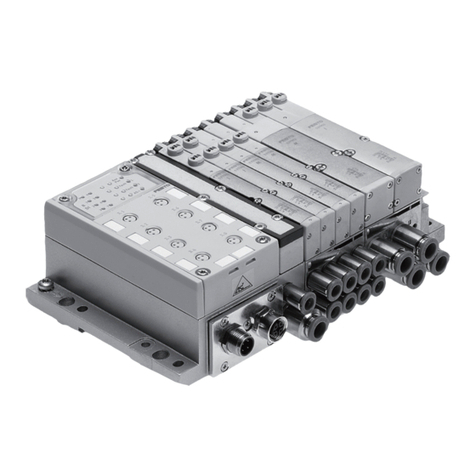
Festo
Festo VTSA-ASI 4E4A-Z Series Brief description
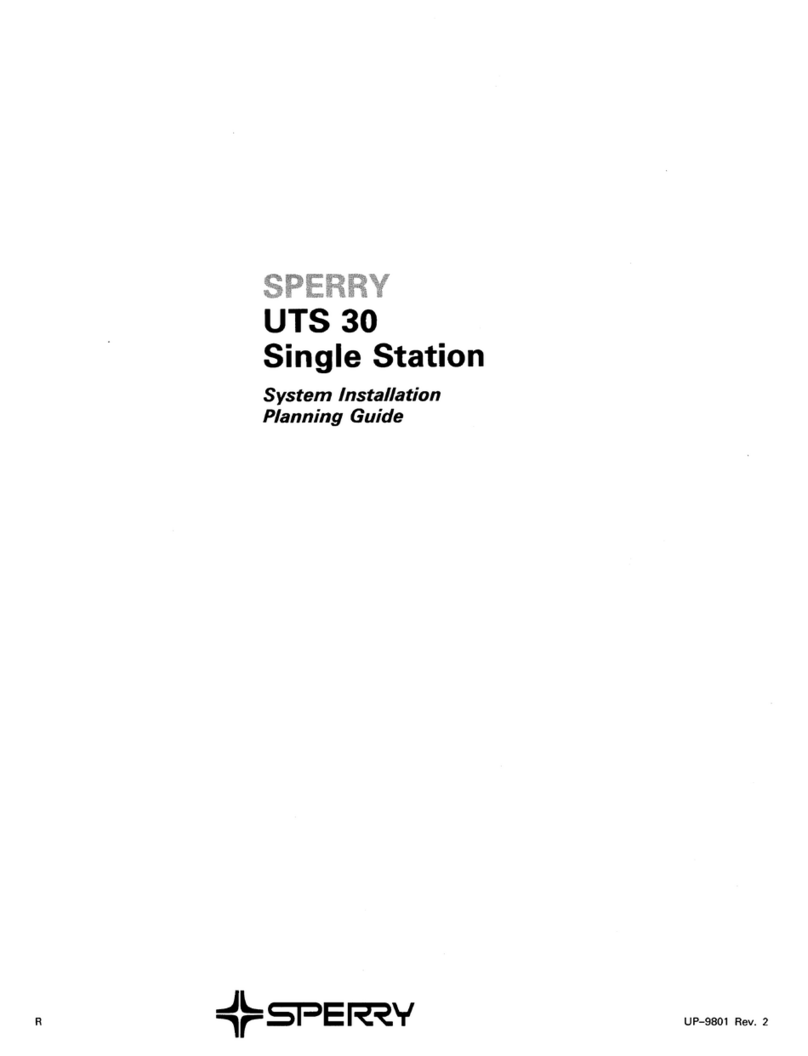
Sperry instrument
Sperry instrument UTS 30 System installation
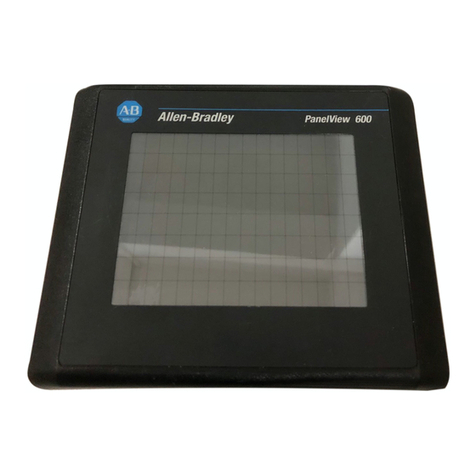
Allen-Bradley
Allen-Bradley PanelView 600 installation instructions

